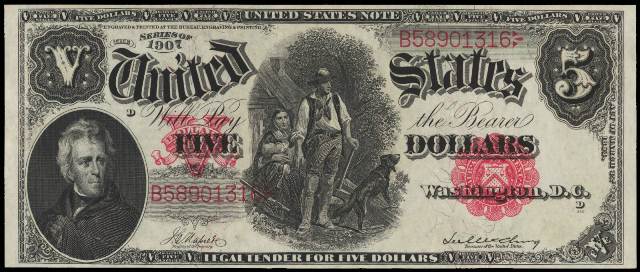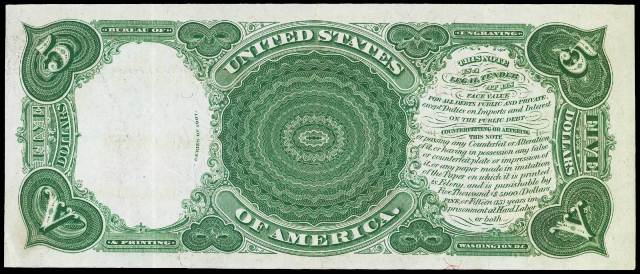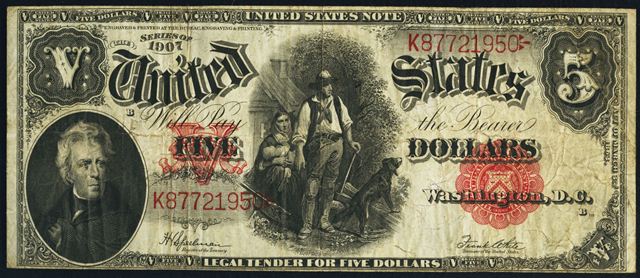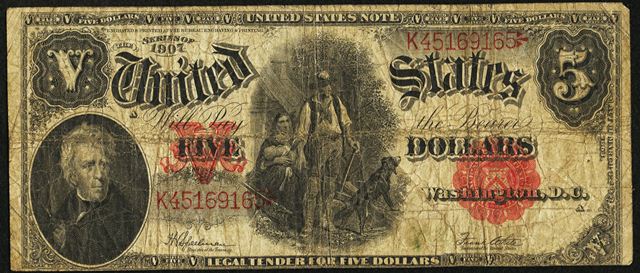Series of 1907 $5 Legal Tender – Woodchopper Note
History: We are looking at the Series of 1907 five dollar legal tender note. It is also sometimes called a United States note. This type of bill was first issued in the early 1860s. In fact, the series of 1869 $5 legal tender note looks almost exactly the same as the 1907 issue. The 1869 specimens were printed on slightly blue paper. 1869, 1875, 1878, 1880, and 1907 five dollar bills all have the same basic layout. Also, don’t be confused by the fact that series of 1907 is written on the bill. Some bills were printed as late as 1927 and 1928. You can tell the basic range of printing years based on the signature combinations used by the signing treasury officials. The series of 1907 $5 bill was the last note of that denomination that Andrew Jackson was featured on. He later made an appearance on the ten dollar bill before being switched to the twenty dollar bill in 1928.
Nickname: The nickname for the 1907 $5 bill is the wood chopper. The note has the portrait of Andrew Jackson on the left hand side. The central image is that of a pioneer family moving west. A husband and wife are pictured with their young baby. There is also a hound dog in the frame. The man is holding an ax. We sometimes here this one called the wood splitter; however, wood chopper is certainly the most well-known nickname.
Other Facts: There is not a whole lot else you need to know about this issue. It of course has a red overprint (aka, red writing). The treasury seal and serial numbers are printed in red ink. There is also a red V printed on the left hand side of the bill in red ink. As you can probably guess, that red V signifies the value as a Roman numeral. It is worth mentioning that there are lots of errors out there on 1907 legal tenders. You can find missing seals, inverted prints, as well as the famous PCBLIC error. The PCBLIC error is so common to the point that it really only commands about a 15% premium with collectors.
Values and Grading: All 1907 $5 bills are fairly common. When the large size currency market was doing well the price of woodchoppers was about 40% higher than it is now. Most lightly circulated examples sell for around $100. As you get nicer then the prices go up, sometimes as high as $1,000. Tens of millions of 1907 $5 legal tender notes were issued, so that means that there are runs of consecutive and uncirculated notes still out there. It is not unusual to find a cut sheet of four notes with sequential serial numbers. Our guide below will tell you more about grading and values.
Choice Uncirculated or Better: Everyone loves perfect; the same applies to choice and gem uncirculated 1907 $5 legal tender notes. If you can afford to spend several hundred dollars then you are going to buy something in the 64-65 range. There is a discount for something graded as a 63, and there is definitely a premium for a 1907 $5 bill in the 66+ grade. Notes in this grade are valued based on their centering. Many 1907 notes have tight top and bottom margins but wide left and right margins. Most collectors are looking for something that is well centered all the way around.

A 1907 $5 Bill This Nice Should Sell For Around $600
Extremely Fine to About Uncirculated: There is not much of a price gap between something graded as extra fine 40 and about uncirculated 58. The 40 might sell for $300 and the 58 should bring around $450. The tight range is because once encapsulated by a third party you really can’t tell much difference between something with 3 light folds and something with one fold. They are both going to have similar eye appeal. The 1907 $5 bill we have pictured below has been graded as a 40. You can see three vertical white fold lines. Any time you see fold lines that are pure white that strong then odds are you are dealing with a pressed note.

This Woodchopper Has Sold In The Past For Around $300
Fine to Very Fine: 1907 five dollar bills in this grade range can still be quite pleasing. All the dark engraving on the front of each bill is good at hiding wear and use that might be more visible on a white field. You can buy a note in fine condition for as little as $75. A nice very fine might cost closer to $200. Prices today are a good bit lower than the peak of the market a few years ago. The woodchopper we have pictured below graded as fine 15. You can see that the paper is still relatively strong and white. The red colors are still striking. You would expect to see fewer folds and less wear as the grade gets higher.

These 1907 Five Dollar Bills Are Readily Available For Around $125
Very Good and Lower: There are lots of 1907 $5 bills in poor condition. A grade of 1, 2, 4, 6, 8, or 10 is very low (on a scale of 70). Expect to find discoloration, tears, stains, rust, pinholes, holes, writing, ink, etc. These are all undesirable qualities that significantly lower the value of any note. Wood choppers in such poor condition are typically only worth around $50, and usually a lot less. There just isn’t much demand for something in such poor condition.

This 1907 $5 Bill Would Likely Grade a 10 of 70. Many Can Look Much Worse.
Need an Appraisal or Offer? We would love a chance to make an offer on your 1907 five dollar bill. Just send us some scans or digital photos of the front and back of your note. We will respond back quickly with a free appraisal and our best offer. Sales@AntiqueMoney.com


